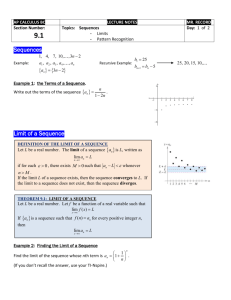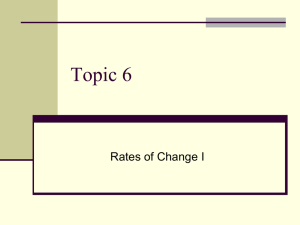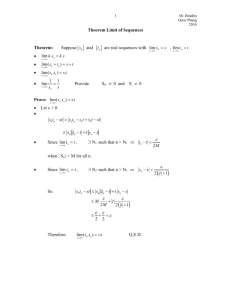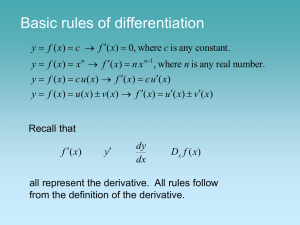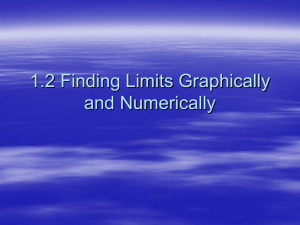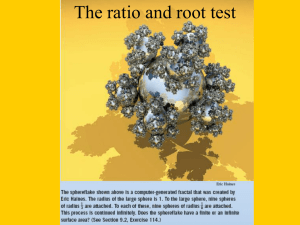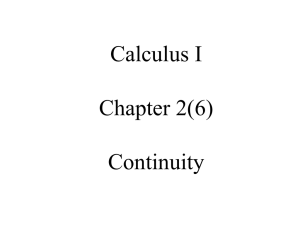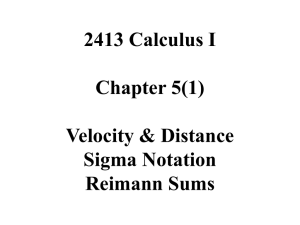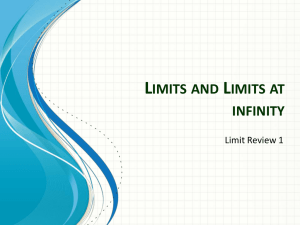Sequence
advertisement
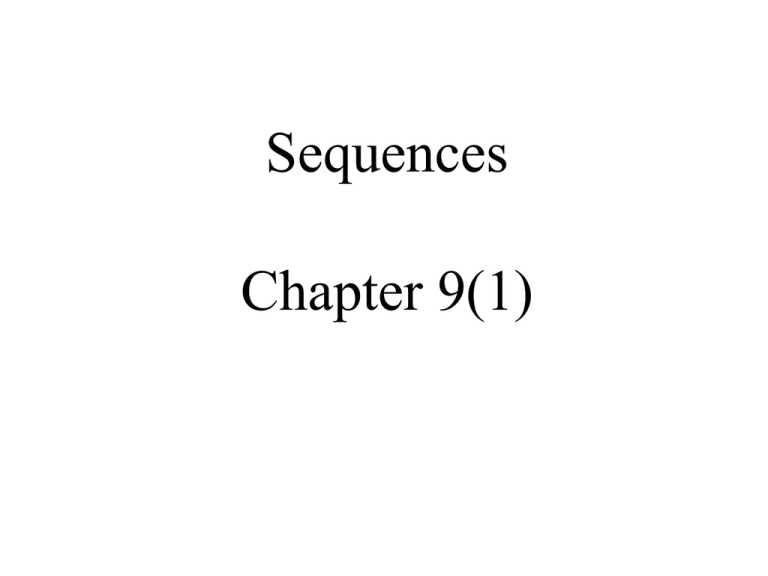
Sequences Chapter 9(1) Sequence Definition and Notation A Sequence is a function whose domain is the positive integers. We use subscript notation to denote terms of a sequence. a1 , a2 , a3 , a4 , ... Terms of a Sequence There are several ways to find terms of a sequence In terms of n an n 3 Recursively based on past terms an 3an1 7 a1 1 3 4 a1 6 (must be given) a2 2 3 5 a3 3 3 6 a2 3(6) 7 25 a3 3(25) 7 82 a20 20 3 23 a4 3(82) 7 253 Limit of a Sequence A sequence that approaches a value is said to Converge. 1 2 , 14 , 18 , 161 , ... 1 1 2 8 1 32 1 64 , , , ,... Converges to 0 Converges to 0 1, , , , ... Convergesto 2 3 1 2 3 5 4 7 , 14 , 18 , 0,... Diverges You can’t tell if a sequence converges just by looking at it. 1 2 Limit of a Sequence Let L be a real number and let f be a function where Lim f ( x) L x If fn = an for each positive integer n, then Lim an L x This ties sequences to functions and we can then use what we have learned about limits of functions to find limits of sequences. Absolute Value Theorem If Lim an 0, then Lim an 0 n n This allows you to find limits when the signs change in a sequence. 1 2 , 1 4 , 81 , 1 16 ,... Converges to 0 Show if the sequence has a limit and find the limit. The sequence is: n 2 an 2 n 1 2 11 a1 32 , a2 65 , a3 10 , ... x 2 Lim 2 x x 1 2 1 So Lim an 1 x Show if the sequence has a limit and find the limit. Lim1 Lim e a1 2, a2 2.25, a3 2.37 The sequence is: x a n 1 1 n n 1 x x Ln 1 1 x x 1 Lim e xLn 1 1x x L’Hopital x Lim e x So Lim an e x 1 1 x1 e Show if the sequence has a limit and find the limit. The sequence is: a1 4, a2 4 34 , a3 4 89 Lim 5 n12 x a n 5 n12 5n 2 1 Lim 5 2 x n So Lim an 5 x Show if the sequence has a limit and find the limit. an ( n1)! ( n2)! The sequence is: a1 2!3! 13 , a2 4!3! 14 , a3 5!4! 15 Lim ( n 1)! ( n 2)! Lim 1 n2 x x ( n 1)( n )( n 1) ... ( n 2)( n 1) n ( n 1)... 1 0 Monotonic Sequence A sequence with terms that are non-decreasing a1 a2 a3 . . . an Or non-increasing a1 a2 a3 . . . an Bounded Sequence A sequence is bounded above if there is a real number M such that an M for all n A sequence is bounded below if there is a real number N such that N an for all n Is the sequence monotonic and/or bounded? Monotonic No Upper Bound Lower Bound: an n2 n 1 a1 12 , a2 34 , a3 94 , ... Lim an n 1 2 (Since it is monotonic it starts at it’s lowest value) Graphing a sequence an n2 n 1 Select MODE, SEQ, and DOT Type in the function Under Window set the n values from 1 to 10 and the x & y max & min
